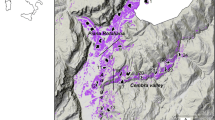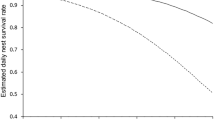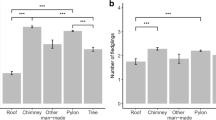Abstract
The Osprey (Pandion haliaetus) is an emblematic example of conservation. Currently, the species is progressively recovering in population size and range after dramatic reductions as a consequence of human persecution and the use of pesticides in the nineteenth and twentieth centuries. Here, we analysed the population trend and productivity in relation to the nesting substrate (artificial structures or trees) and the protection status of the nest location (inside or outside protected areas) in the eastern German population of Ospreys. The Osprey population steadily grew during the study period (2000–2009), accompanied by the increased use of artificial structures for nesting, possibly due to the scarcity of suitable natural nest sites in the region. Pairs nesting in trees showed higher variance in productivity than those nesting on artificial supports during the study period. Further, the productivity recorded in Ospreys nesting on natural sites decreased during the study period, regardless of the protection status of the nest location, whereas it did not vary for pairs nesting on artificial structures. The productivity of Ospreys was also related to the protection status of the nest location since pairs breeding inside protected areas, either in natural or on artificial nest sites, showed higher productivity than pairs nesting outside protected areas. These findings suggest that the protection of the nest location and the type of substrate used for nesting are relevant factors underlying the breeding performance in this Osprey population and are therefore key to its management.
Zusammenfassung
Reproduktion des Fischadlers hängt vom Schutzstatus der Horstumgebung und vom Nistplatztyp ab
Der Fischadler (Pandion haliaetus) ist ein Wahrzeichen für erfolgreichen Artenschutz. Nach dramatischem Rückgang durch menschliche Verfolgung und Pestizide im 19. und 20. Jahrhundert stieg die Populationsgröße in den letzten Jahrzehnten wieder an, und in vielen Regionen hat sich auch das Areal vergrößert. Hier analysieren wir den Populationstrend und die Reproduktion von Fischadlern in Ostdeutschland in Abhängigkeit vom Nistplatztyp (künstliche Strukturen vs. Bäume) und dem Schutzstatus des Nistplatzes (innerhalb vs. außerhalb von Naturparks, Biosphärenreservaten und einem Nationalpark). Die Fischadlerpopulation ist im betrachteten Zeitraum 2002–2009 stetig gestiegen, wobei—wohl in Ermangelung geeigneter alter Nistbäume—zunehmend anthropogene Strukturen, vor allem Gittermasten genutzt werden. Paare, die auf Bäumen nisten, zeigen eine höhere Varianz in der Zahl der Nachkommen als Paare, die auf künstlichen Strukturen nisten. Die Reproduktion der Fischadler auf natürlichen Nistplätzen hat im Verlauf der Untersuchungszeit abgenommen, unabhängig vom Schutzstatus der Umgebung. Dagegen hat sich Reproduktion der Fischadler auf künstlichen Strukturen nicht verändert. Paare innerhalb von Schutzgebieten hatten eine höhere Produktivität als Paare außerhalb von Schutzzonen, egal ob auf natürlichen oder künstlichen Nistplätzen. Die Ergebnisse weisen darauf hin, dass Schutzgebiete und der Nistplatztyp für die Reproduktion in dieser Fischadlerpopulation und ihr Management relevant sind.




Similar content being viewed by others
References
Bai M-L, Schmidt D, Gottschalk E, Mühlenberg M (2009) Distribution pattern of an expanding Osprey (Pandion haliaetus) population in a changing environment. J Ornithol 150:255–263. doi:10.1007/s10336-008-0345-3
Baril LM, Smith DW, Drummer T, Koel TM (2013) Implications of cutthroat trout declines for breeding Ospreys and Bald Eagles at Yellowstone Lake. J Raptor Res 47:234–245. doi:10.3356/JRR-11-93.1
Bierregaard RO, Poole AF, Washburn BE (2014) Ospreys (Pandion haliaetus) in the 21st century: populations, migration, management, and research priorities. J Raptor Res 48:301–308. doi:10.3356/0892-1016-48.4.301
Camacho C, Palacios S, Sáez P et al (2014) Human-induced changes in landscape configuration influence individual movement routines: lessons from a versatile, highly mobile species. PLoS ONE 9:e104974. doi:10.1371/journal.pone.0104974
Cardador L, Carrete M, Mañosa S (2011) Can intensive agricultural landscapes favour some raptor species? The Marsh harrier in north-eastern Spain. Anim Conserv 14:382–390. doi:10.1111/j.1469-1795.2011.00449.x
Caro T, Gardner TA, Stoner C et al (2009) Assessing the effectiveness of protected areas: paradoxes call for pluralism in evaluating conservation performance. Divers Distrib 15:178–182. doi:10.1111/j.1472-4642.2008.00522.x
Cartron JLE (2000) Status and productivity of Ospreys along the eastern coast of the Gulf of California: 1992–1997. J Field Ornithol 71:298–309
Castellanos A, Ortega-Rubio A (1995) Artificial nesting sites and Ospreys at Ojo de Liebre and Guerrero Negro lagoons, Baja California Sur, Mexico. J Field Ornithol 66:117–127
Clark PJ, Evans FC (1954) Distance to nearest neighbor as a measure of spatial relationships in populations. Ecology 35:445–453
Coetzee BWT, Gaston KJ, Chown SL (2014) Local scale comparisons of biodiversity as a test for global protected area ecological performance: a meta-analysis. PLoS ONE 9:e105824. doi:10.1371/journal.pone.0105824
Devictor V, Godet L, Julliard R et al (2007) Can common species benefit from protected areas? Biol Conserv 139:29–36. doi:10.1016/j.biocon.2007.05.021
Donazar JA, Ceballos O (1989) Selective predation by Eagle Owl Bubo bubo on rabbits Oryctolagus cuniculus: age and sex preferences. Ornis Scand 20:117–122
Donazar JA, Hiraldo F, Bustamante J (1993) Factors influencing nest site selection, breeding density and breeding success in the bearded vulture. J Appl Ecol 30:504–514
Ewins P (1996) The use of artificial nest sites by an increasing population of Ospreys in the Canadian Great Lakes Basin. In: Bird D, Varland D, Negro J (eds) Raptors in human landscapes: adaptations to built and cultivated environments. Academic, San Diego, pp 109–123
Ferrer M, Donazar JA (1996) Density-dependent fecundity by habitat heterogeneity in an increasing population of Spanish Imperial Eagles. Ecology 77:69–74. doi:10.2307/2265655
Ferrer M, Hiraldo F (1991) Evaluation of management techniques for the Spanish imperial eagle. Wildl Soc Bull 19:436–442
Ferrer M, Hiraldo F (1992) Man-induced sex-biased mortality in the Spanish imperial eagle. Biol Conserv 60:57–60. doi:10.1016/0006-3207(92)90799-S
Ferrer M, Newton I, Casado E (2008) Density dependence hypotheses and the distribution of fecundity. J Anim Ecol 77:341–345. doi:10.1111/j.1365-2656.2008.01471.x
Gelman A, Hill J (2006) Data analysis using regression and multilevel/hierarchical models. Cambridge University Press, Cambridge
González LM, Bustamante J, Hiraldo F (1990) Factors influencing the present distribution of the Spanish imperial eagle Aquila adalberti. Biol Conserv 51:311–319. doi:10.1016/0006-3207(90)90116-7
Grove RA, Henny CJ, Kaiser JL (2009) Osprey: worldwide sentinel species for assessing and monitoring environmental contamination in rivers, lakes, reservoirs, and estuaries. J Toxicol Environ Health B 12:25–44. doi:10.1080/10937400802545078
Janzen DH (1986) The eternal and external threat. In: Soulé ME (ed) Conservation Biology: the Science and Scarcity and Diversity. Sinauer Associates, Sunderland, MA, pp 286–303
Johnston RF (2001) The synanthropic birds of North America. In: Marzluff JM, Bowman R, Donnelly R (eds) Avian ecology and conservation in an urbanizing world. Kluwer, Norwell, pp 49–67
Kapfer JM, Mueller WP, Bub BR, Engelhardt JW (2010) The response of nesting Ospreys (Pandion haliaetus) to maintenance activities along transmission lines in central Wisconsin. Passeng Pigeon 72:3–11
Kuznetsova A, Brockhoff PB, Christensen RHB (2015) lmerTest: tests in linear mixed effects models. R package version 2.0-32. https://CRAN.R-project.org/package=lmerTest
Langgemach T, Thoms M, Litzkow B, Stein A (2008) Horstschutz in Brandenburg. Ber Vogelschutz 45:39–50
Legendre P, Legendre L (1998) Numerical ecology, 2nd edn. Elsevier, Amsterdam
Lõhmus A (2001) Habitat selection in a recovering Osprey Pandion haliaetus population. Ibis (Lond 1859) 143:651–657. doi:10.1111/j.1474-919X.2001.tb04893.x
Marzluff J, McGowan K, Donelly R, Richard L (2001) Causes and consequences of expanding American Crow populations. In: Marzluff JM, Bowman R, Donelly R (eds) Avian ecology and conservation in an urbanizing world. Kluwer, Norwell, pp 332–363
Matesanz S, Gimeno TE, de la Cruz M, Escudero A, Valladares F (2011) Competition may explain the finescale spatial patterns and genetic structure of two co-occurring plant congeners. J Ecol 99:838-848
Meyburg BU, Manowsky O, Meyburg C (1996) The Osprey in Germany: its adaptation to environments altered by man. In: Bird D, Varland D, Negro J (eds) Raptors in human landscapes. adaptations to built and cultivated environments. Academic, San Diego, pp 125–135
Newton I (1979) Population ecology of raptors. Poyser, Berkhamsted
Newton I, Marquiss M, Weir D, Moss D (1977) Spacing of Sparrowhawk nesting territories. J Anim Ecol 46:425–441
Oden NL, Sokal RR (1986) Directional autocorrelation: an extension of spatial correlograms to two dimensions. Syst Zool 35:608–617. doi:10.2307/2413120
Pedrini P, Sergio F (2001) Density, productivity, diet, and human persecution of Golden Eagles (Aquila chrysaetos) in the central-eastern Italian Alps. J Raptor Res 35:40–48
Poole A (1981) The effect of human disturbance on Osprey reproductive success. Col Waterbirds 4:20–27
Poole A (1989a) Ospreys: a natural and unnatural history. Cambridge University Press, Cambridge
Poole AF (1989b) Regulation of Osprey Pandion haliaetus populations: the role of nest side availability. In: Meyburg R, Chancellor B (eds) Raptors in the modern world. World Working Group on Birds of Prey, Berlin
Postupalsky S (1978) Artificial nesting platforms for Ospreys and Bald Eagles. In: Temple SA (ed) Endangered birds: management techniques for observing endangered species. University of Wisconsin Press, Madison, pp 35–45
R Core Team (2016) R: a language and environment for statistical computing. R Foundation for Statistical Computing, Vienna
Rodríguez B, Rodríguez A, Siverio M, Siverio F (2013) Conservation implications of past and present nesting habitat selection of the endangered Osprey Pandion haliaetus population of the Canary Islands. Ibis (Lond 1859) 155:891–897. doi:10.1111/ibi.12089
Saurola P (1997) The Osprey (Pandion haliaetus) and modern forestry: a review of population trends and their causes in Europe. J Raptor Res 31:129–137. doi:10.3356/JRR-13-OSPR-13-03.1
Schmidt D (2010) Der Brutbestand des Fischadlers Pandion haliaetus in Deutschland im frühen 21. Jahrhundert. Charadriuos 10–17
Schmidt-Rothmund D, Dennis R, Saurola P (2014) The Osprey in the western Palearctic: breeding population size and trends in the early 21st century. J Raptor Res 48:375–386
Sergio F, Boto A, Scandolara C, Bogliani G (2002) Density, nest sites, diet and productivity of Common Buzzards (Buteo buteo) in the Italian pre-Alps. J Raptor Res 36:24–32
Thiollay JM (2006) The decline of raptors in West Africa: long-term assessment and the role of protected areas. Ibis (Lond 1859) 148:240–254. doi:10.1111/j.1474-919X.2006.00531.x
Trimper PG, Standen NM, Lye LM et al (1998) Effects of low-level jet aircraft noise on the behaviour of nesting osprey. J Appl Ecol 35:122–130. doi:10.1046/j.1365-2664.1998.00290.x
Van Daele LJ, Van Daele HA (1982) Factors affecting the productivity of ospreys nesting in west-central Idaho. Condor 84:292–299
Acknowledgements
We thank all the nest site caretakers in the state of Brandenburg who provided all basic data and contribute to Osprey conservation in the field. We also thank Torsten Ryslavy for collecting and managing the data, and Phil Whitfield and one anonymous referee for their constructive comments on the manuscript.
Author information
Authors and Affiliations
Corresponding author
Additional information
Communicated by O. Krüger.
Rights and permissions
About this article
Cite this article
Canal, D., Morandini, V., Martín, B. et al. Productivity is related to nest site protection and nesting substrate in a German Osprey population. J Ornithol 159, 265–273 (2018). https://doi.org/10.1007/s10336-017-1498-8
Received:
Revised:
Accepted:
Published:
Issue Date:
DOI: https://doi.org/10.1007/s10336-017-1498-8




